6 Common Challenges Runners Experience in Yoga—And How to Overcome Them
This article originally appeared on Yoga Journal
Runners come in all shapes, sizes, speeds, and experience levels. Yet there are general truths related to being a runner, and one of them is having to deal with muscles that feel tight or tense.
Lower-body muscle tension can provide joint stability each time your shoes hit the pavement or trail, help you bounce back after impact, and propel you forward in much the same way that a tight elastic band snaps back more powerfully than a loose one.
The same tension that is beneficial to your running is the very thing that you might find challenging when practicing yoga. But yoga's benefit to runners is directly proportional to its challenge. And part of that benefit is not needing to change what makes you a strong runner. You simply need to change your approach to yoga.
How Yoga and Running Complement One Another
Practicing other types of movement outside of running can help you become even more resilient. This we know.
On the physical side, integrating yoga into your run training can help ease muscle tension and improve your range of motion. It also draws your awareness to areas of tightness and helps you identify muscular imbalances.
Also, the mindful movement needed to move from one yoga pose to another improves your balance, body control, and proprioception, which translates to more confident and efficient movement on varied terrain, whether you're hopping up on sidewalks or navigating trails.
Yoga's ongoing attention to your internal state can also help you tune into early warning signs of irritation that often predate injury but tend to be overlooked in the loudness of life.
Finally, by cultivating an inward focus, yoga helps you tap into your current energetic state, to get a feel for when you can push, when you should maintain, and when you need to dial things back.
Yoga offers you an array of movement, breathing, and awareness practices that you can use to steady yourself on the start line of a race and support your recovery the moment you cross the finish line.
6 Yoga and Running Challenges--And How to Fix Them
Yes, there are major benefits yoga can provide to runners. But there are also challenges runners tend to face when starting up a yoga practice. Here's how those common challenges can be turned into benefits, and how yoga can enhance your run training.
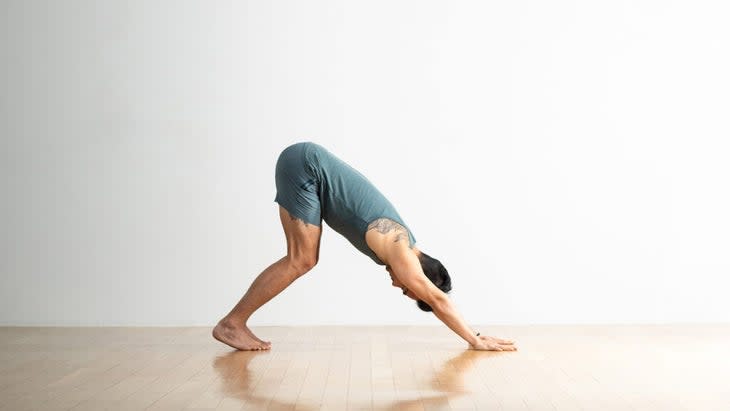
1. If You Have Tight Hamstrings…
It doesn't take long for a runner to become intimately aware of just how much hamstring stretching happens in an average yoga class. It may seem as though other students fold forward over their legs with ease or reach their heels to the mat in Downward-Facing Dog (Adho Mukha Svanasana) without thought.
Runners tend to have a very different experience. Not to worry. The solution is not aggressively forcing your body to assume the shape of the person next to you.
The solution: Tension in your hamstrings can create a feeling of failure whenever a pose demands flexibility. But think of your muscle tension as stored energy, similar to the elastic recoil which literally propels you forward each time your foot hits the ground. Reconsidered in this fashion, your tightness becomes something to appreciate rather than eradicate. With that understanding, you might think about releasing rather than pulling taut and easing rather than pushing through.
This becomes most obvious in any pose that asks you to bend forward. Rather than forcing your chest to come close to your leg, focus on feeling a gentle stretch in the middle--the belly--of your hamstrings.
In practical terms, that usually means keeping the knee(s) of your stretching leg(s) slightly bent. It could also mean using blocks beneath your hands so the ground lifts to meet you. Remember: release and ease.
The poses:
Downward-Facing Dog (Adho Mukha Svanasana)
Standing Forward Bend (Uttanasana)
Pyramid Pose (Parsvottanasana)
Seated Forward Bend (Paschimottanasana)
Head-to-Knee Pose (Janu Sirsasana)
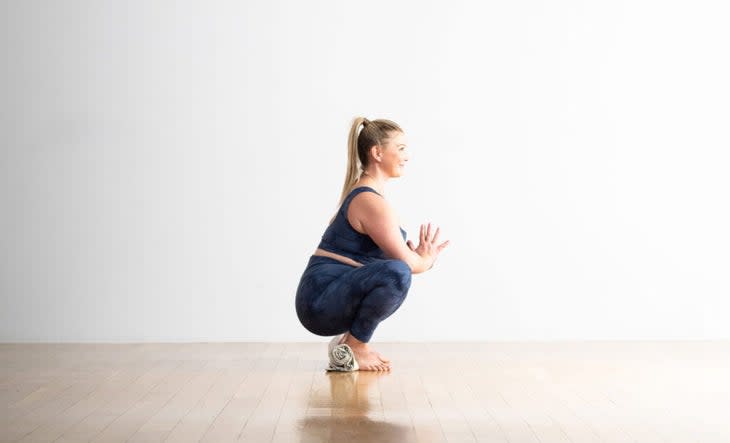
2. If You Have Tight Calves…
Everyone around you is in Downward Dog and their heels seem to easily touch the mat while yours tower above it, your calves screaming. Or you're in Warrior 1 and your back heel simply won't connect to the mat.
The solution: You don't need to bring your heels in contact with the mat in some poses, including Downward Dog, to get a beneficial calf stretch. Let your heels reach toward the mat but don't worry if they don't touch. Instead, use the weight of your heels to create a subtle sense of stretching or lengthening in the calf muscles.
In certain standing poses, it's essential for your overall body engagement to ground your back heel, such as in Pyramid or Warrior 1 (Virabhadrasana I). If you simply cannot ground your heel to your mat, consider shortening your stance slightly. You can also experiment with sliding a rolled blanket beneath your back heel or rolling the back of your mat a couple times to give your heel something higher than the floor to press against.
The poses:
Downward-Facing Dog (Adho Mukha Svanasana)
Squat (Malasana)
Pyramid (Parsvottanasa)
Warrior 1 (Virabhadrasana 1)
Side Lunge or Flying Monkey
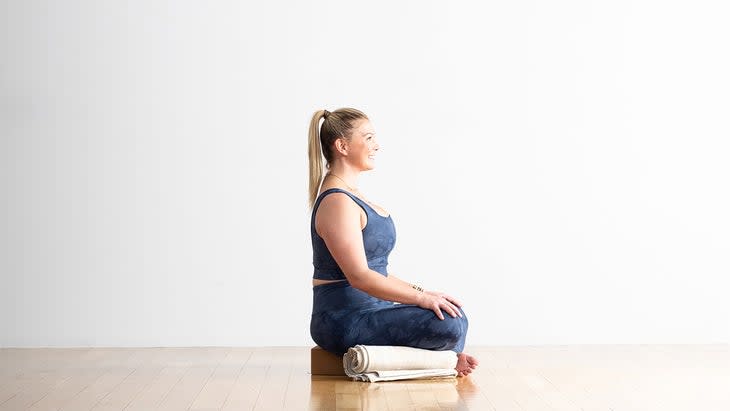
3. If You Have Tight Hips…
The classic image associated with yoga is a student sitting comfortably cross-legged, knees resting comfortably on the floor and an expression of bliss on their face. Hip openers like the classic cross-legged seat are said to bring up stored emotions in yoga students. The dominant emotion that may arise for runners is likely frustration--especially when that pose is accompanied by an invitation to fold your torso forward over your legs.
The solution: Perspective: Tension in your glutes, similar to tightness in your hamstrings and calves, helps propel you forward in your running stride, and tension in your back muscles helps hold your torso upright as you run, enables you to breathe, and absorbs the impact of each footstrike. These are valuable adaptations your body has made to run training. Instead of viewing them as impediments to deep hip openers, know that you still receive the benefits of stretches but with less range of motion than other students.
Rather than being concerned about how your cross-legged sitting poses and forward bends look, focus on finding a version of the pose that allows your hard-working muscles to feel a sense of release or relaxation. When you experience a gentle stretch, whether in your glute(s), outer hip(s), inner thigh(s), or down your back, you are in the right version of the pose for you. There's no need to go deeper.
If you're sitting cross-legged, using props beneath your knees or thighs or leaning back on your hands rather than bending forward can make the stretch more tolerable. You can reach for blocks, a rolled towel, even a water bottle. In Pigeon Pose, propping yourself up with straight arms creates more space between your torso and your front leg and reduces the amount of hip flexion required. Once again, it's about the pose meeting your needs rather than trying to force yourself to meet its shape.
The poses:
(So-Called) "Easy" Pose (Sukhasana)
Pigeon Pose (Eka Pada Rajakapotasana)
Bound Angle Pose (Baddha Konasana)
Lizard Pose (Utthan Pristhasana)
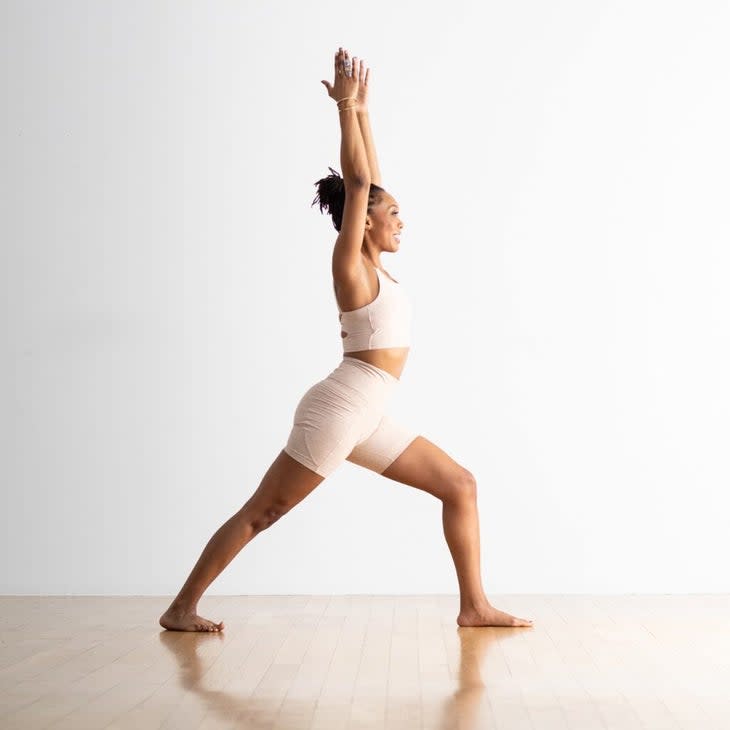
4. If You Have Lower Body Fatigue…
Although yoga brings more than just physical benefits, some students turn to the practice as their primary source of working out. For them, it makes sense to challenge their leg strength by bending their knees more deeply in certain poses, or hold standing poses as long as possible to maximize muscle engagement in each moment.
Runners might come to a yoga class straight from a run, or be practicing yoga the day after a particularly hard run. In either case, your legs may feel heavy and sluggish when you arrive on your mat. Or, if you plan to run any time after your yoga class but on the same day, you may be wanting to reserve your expenditure of lower body strength for when it matters most to you.
The solution: Exert yourself less than you are able. Bend your knees less deeply in Warrior poses or Chair. Keep your stance a little shorter in Triangle and Pyramid. By setting up your physical shape to challenge your lower body less intensely, you allow yourself to focus on mobility and flexibility rather than brute strength. It might take a little acclimating not to give everything on the mat--you're an athlete, after all--but easing back will enable you to reserve your best efforts for your run training.
The poses:
Chair Pose (Utkatasana)
Goddess Pose (Utkata konasana)
Warrior 1 (Virabhadrasana 1)
Warrior 2 (Virabhadrasana 2)
Extended Side Angle Pose (Utthita Parsvakonasana)
Triangle Pose (Trikonasana)
Pyramid Pose (Parsvottanasana)
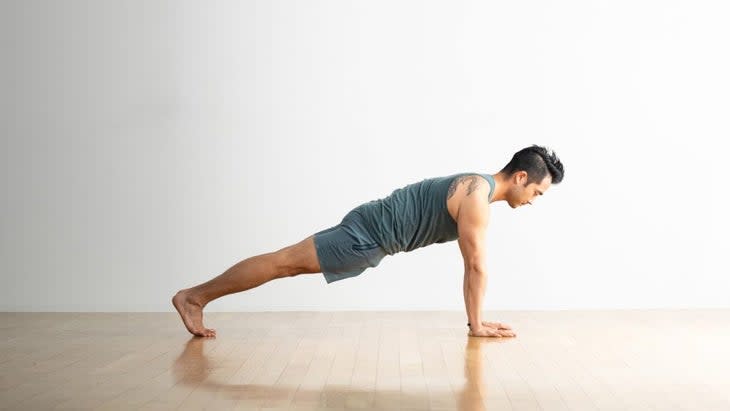
5. If You Have Upper Body Strength Challenges…
Running prioritizes leg and hip muscles rather than those in your upper body. After all, you run on your feet, not your hands. But this comes at the expense of your wrist, arm, and shoulder muscles, which means the amount of time spent on your hands in yoga class can create unwelcome sensations for many runners.
Multiple high planks, low planks, side planks, and even the supposed "resting" option of Down Dog feels challenging enough for frequent yoga students. For those who don't regularly work to build upper body strength, these poses can elicit an extra psychological sting.
The solution: Unlike poses that emphasize your lower body, these are the poses that you can treat like training. Approach them with a little more drive and discipline, knowing that the weight-bearing strength you build here can both make you more resilient, and actually help improve your running. Having a strong upper body allows a better arm drive, improve your balance, and maintain good form. Find versions of these poses that you want to linger in for an extended period of time, or repeat an extra time or two. And challenge yourself to approach them without expectation of performance, but be willing to place equal value on the experience of trying something new and building strength.
The poses:
Downward-Facing Dog (Adho Mukha Svanasana)
Plank Pose (Phalakasana)
Side Plank (Vasisthasana)
Chaturanga (Low Push Up))
Arm balances like Crow or Crane Pose (Bakasana)
Inversions such as Handstand (Adho Mukha Vrksasana)
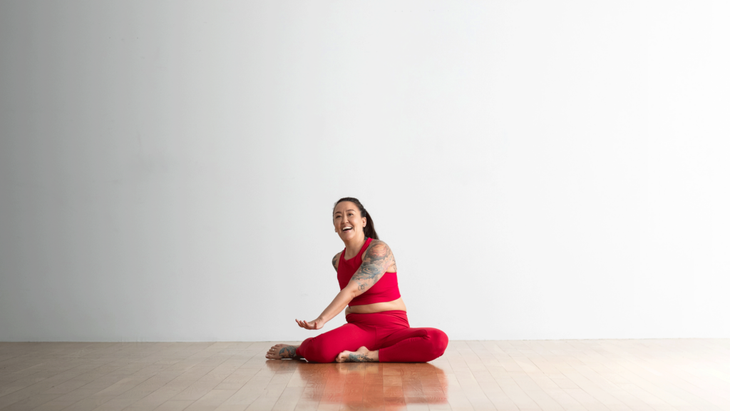
6. If You Have a Competitive Mindset…
Confronting your expectations can be one of the biggest challenges facing any student of yoga. For runners, the disciplined and competitive drive that is helpful in your run training can actually get in the way of deriving benefits from your yoga practice.
If you're used to comparing your performance to that of those around you, it can be easy to forget that other students in a yoga class may have adapted to yoga the same way that you've acclimated to your running. Disparaging yourself for your abilities in yoga would be like comparing a sprinter to an endurance runner and expecting their needs, goals, and outputs to be the same.
Runners who are inwardly driven by their own metrics might be hard on themselves if, from one week to another, they feel they "perform" better or worse in a yoga class. Keep in mind that you may feel better, be able to hold poses for longer, or stretch deeper in yoga class during a week where you had light run training load than you do the week of a more demanding training block.
The solution: All of these are compelling reasons to run toward, not away from, a yoga class, even if you don't feel like the star student. It's okay not to "win" or even "progress" at yoga, and that's actually the point. You are there to cross-train rather than compete. You don't ever need to "master" yoga asana practice. It's enough to restore tight or tired tissues, to build balanced strength, and to cultivate a little sukha, or ease, to balance the sthira, or discipline, that you've already honed by running. Just like hill repeats are different from speed drills which are different from easy recovery runs, yoga does not need to feel like your other training efforts.
As you do in your run training, focus on your purpose. When you understand yoga for what it is--a tradition of practices for body, mind, and even spirit--there's potential to add tools and awareness that can supplement your running in unexpected ways. Yoga encourages you to soften where you are strong, and strengthen where you are soft. It suggests that practice is as important as performance, acceptance as powerful as achievement. And by giving you opportunities to address your weaknesses or imbalances, yoga reminds you of your existing strengths even as it helps you create new ones.
About Our Contributor
Rachel Land is a Yoga Medicine instructor offering group and one-on-one yoga sessions in Queenstown New Zealand, as well as on-demand at practice.yogamedicine.com. Passionate about the real-world application of her studies in anatomy and alignment, Rachel uses yoga to help her students create strength, stability, and clarity of mind. Rachel also co-hosts the new Yoga Medicine Podcast.
For exclusive access to all of our fitness, gear, adventure, and travel stories, plus discounts on trips, events, and gear, sign up for Outside+ today.

